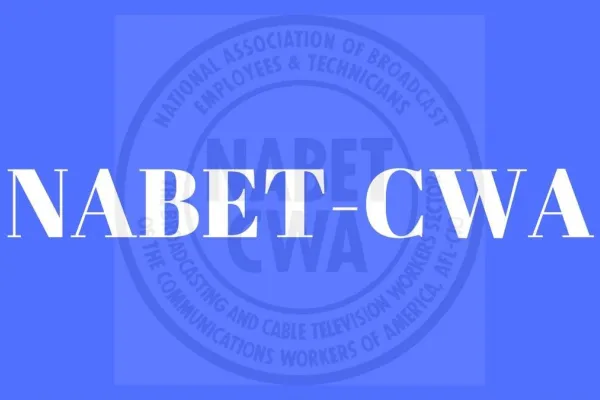News, Sports Operations Covid-19 Safety Guidelines
As we enter another month of the COVID-19 global pandemic amid continuing uncertainty, one thing that has remained constant is our collective membership’s commitment to the important mission of delivering high-quality, timely, and important programming to the public. Our members have continued to report to work despite significant health and safety risks, while others have adapted to working from home. While many companies have already taken significant steps to make the workplace safer and to reduce the risk to employees reporting to work, we believe there are additional steps that companies must take, including in the critical area of testing, to ensure a safer workplace.
As the labor unions representing professional workers in the broadcast and media industry, we believe it is critical that companies in the industry continue to engage in informed discussions about COVID-19 as it impacts our members – their employees – who have been working in company facilities or in the field or will soon be returning from work from home arrangements. Last month, a coalition of industry labor unions, in consultation with leading epidemiologists and experts, released The Safe Way Forward, a detailed set of science-based protocols serving as a path for employers to uphold their responsibility of providing safe workplaces in a pre-vaccine, COVID-19 world. Earlier, the same unions, together with motion picture and television producers, published a “White Paper” with health and safety guidelines after consultation with health experts, CDC and OSHA guidelines. Both reports concluded that a mandatory and comprehensive testing regimen is the cornerstone of a safe return to production. The reports set forth detailed instructions on the implementation of these concepts for entertainment productions, but the concerns they address, especially those involving employees who are required to work in close proximity, are also applicable to news, sports, and operations. As testing becomes more available, we urge companies to facilitate regular, periodic testing for employees reporting to work. Without testing, the entire workforce is being asked to work each day in an environment of unknown risk. Companies must take all necessary precautions to protect and maintain the confidentiality of employees’ protected health information.
Universal symptom monitoring, including temperature screening, may be used to further mitigate risk, but is not, without a COVID-19 testing protocol, an effective precautionary measure against the spread of the virus. First, someone could be running a temperature for any number of reasons; second, many people shed the virus while completely asymptomatic, or are infectious before they become febrile; and third, temperature testing has historically led to a false sense of security. Besides testing, there are several other standards which, broadly speaking, must be met to further reduce the risk of transmission in the workplace:
Personal Protective Equipment: Masks and gloves should be readily available upon entry to all facilities where our members report to work, and the use of masks should be mandated in appropriate areas. Sufficient quantities of disinfectant wipes and hand sanitizer should be available in all control rooms, studios, production vehicles, and other common areas. Hand soap should regularly be replenished in all bathrooms and common areas, and all present in the facilities should be encouraged to wash their hands for at least 20 seconds often.
Social Distancing: Companies must ensure adequate social distancing of at least 6 feet between employees in all company facilities and in the field. This may require modifying control rooms, studios, newsrooms, production vehicles, and remote sites to increase the physical space between all operational positions. If that is not possible, the company must install plexiglass dividers. companies must also limit the number of employees gathered in common areas, such as elevators, bathrooms, and cafeterias.
Cleaning and Disinfecting: Studios, control rooms, production vehicles, attendant equipment, computers, and other frequently touched surfaces should be cleaned and disinfected by trained personnel using EPA-approved chemicals between each shift. Appropriate care should also be given to protecting employees from hazardous chemicals used. The companies should provide notification when an area has been cleaned, such as with a sign, or a cleaning log.
Communication: Companies should inform employees about their safety protocols, and designate who employees should contact for specific issues, questions, or concerns. In addition, the companies should promptly and regularly communicate to employees any changes and developments. Companies should place signs reminding employees of the obligation to wear PPE and maintain social distancing.
The precautions required for containing COVID-19 will change as the science surrounding the virus evolves. We expect that, over time, there will be a better understanding of immunity, and a vaccine may be developed. Until that time, we firmly believe that COVID-19 testing, in addition to the other standards outlined above, is critical to ensure a safer workplace for employees.
Endorsed by:
The Department for Professional Employees, AFL-CIO Directors Guild of America
IATSE, AFL-CIO,
IATSE, Local 600, IBEW, AFL-CIO, IBEW, Local 5,
IBEW, Local 82, IBEW, Local 245, IBEW, Local 1200, IBEW, Local 1212,
NABET, CWA, AFL-CIO,
The NewsGuild, CWA, AFL-CIO,
The NewsGuild of New York, Local 31003, CWA, AFL-CIO, SAG-AFTRA, AFL-CIO, and
WGA-East, AFL-CIO.
NABET-CWA Bulletin: NBCUniversal/Versant (MSNBC)


